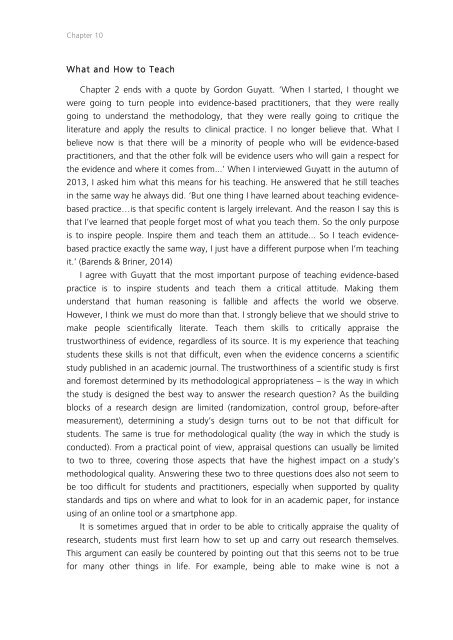In Search of Evidence
jqluvth
jqluvth
You also want an ePaper? Increase the reach of your titles
YUMPU automatically turns print PDFs into web optimized ePapers that Google loves.
Chapter 10<br />
What and How to Teach<br />
Chapter 2 ends with a quote by Gordon Guyatt. ‘When I started, I thought we<br />
were going to turn people into evidence-based practitioners, that they were really<br />
going to understand the methodology, that they were really going to critique the<br />
literature and apply the results to clinical practice. I no longer believe that. What I<br />
believe now is that there will be a minority <strong>of</strong> people who will be evidence-based<br />
practitioners, and that the other folk will be evidence users who will gain a respect for<br />
the evidence and where it comes from...’ When I interviewed Guyatt in the autumn <strong>of</strong><br />
2013, I asked him what this means for his teaching. He answered that he still teaches<br />
in the same way he always did. ‘But one thing I have learned about teaching evidencebased<br />
practice…is that specific content is largely irrelevant. And the reason I say this is<br />
that I’ve learned that people forget most <strong>of</strong> what you teach them. So the only purpose<br />
is to inspire people. <strong>In</strong>spire them and teach them an attitude... So I teach evidencebased<br />
practice exactly the same way, I just have a different purpose when I’m teaching<br />
it.’ (Barends & Briner, 2014)<br />
I agree with Guyatt that the most important purpose <strong>of</strong> teaching evidence-based<br />
practice is to inspire students and teach them a critical attitude. Making them<br />
understand that human reasoning is fallible and affects the world we observe.<br />
However, I think we must do more than that. I strongly believe that we should strive to<br />
make people scientifically literate. Teach them skills to critically appraise the<br />
trustworthiness <strong>of</strong> evidence, regardless <strong>of</strong> its source. It is my experience that teaching<br />
students these skills is not that difficult, even when the evidence concerns a scientific<br />
study published in an academic journal. The trustworthiness <strong>of</strong> a scientific study is first<br />
and foremost determined by its methodological appropriateness — is the way in which<br />
the study is designed the best way to answer the research question? As the building<br />
blocks <strong>of</strong> a research design are limited (randomization, control group, before-after<br />
measurement), determining a study’s design turns out to be not that difficult for<br />
students. The same is true for methodological quality (the way in which the study is<br />
conducted). From a practical point <strong>of</strong> view, appraisal questions can usually be limited<br />
to two to three, covering those aspects that have the highest impact on a study’s<br />
methodological quality. Answering these two to three questions does also not seem to<br />
be too difficult for students and practitioners, especially when supported by quality<br />
standards and tips on where and what to look for in an academic paper, for instance<br />
using <strong>of</strong> an online tool or a smartphone app.<br />
It is sometimes argued that in order to be able to critically appraise the quality <strong>of</strong><br />
research, students must first learn how to set up and carry out research themselves.<br />
This argument can easily be countered by pointing out that this seems not to be true<br />
for many other things in life. For example, being able to make wine is not a


